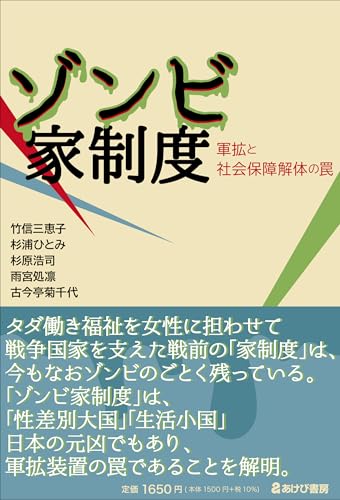2012.02.01 Wed
Just past 3pm on March 11, 2011, a call was made to Tanoura Beach from Iwaishima. “We just had an earthquake. Please evacuate the beach immediately for fear of possible tsunami.” Upon hearing this announcement, young people on the beach hurriedly took their kayaks and other important leisure items to the nearby hilltops, and approximately half of them returned to Iwaishima for safety.
(see photo #0)
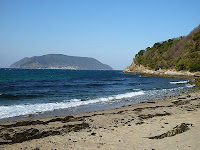 |
| Photo #0 |
 |
| Photo #1 |
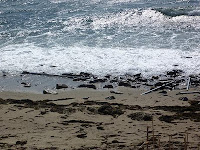 |
| Photo #2 |
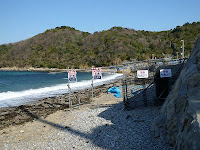 |
| Photo #4 |
Pillars and stakes are remains from the net and ropes erected by Chuden to stop the protesters from coming down the slope to the beach, and the oil fence was an underwater curtain which Chuden tried to install in the bay to stop the people from Iwaishima to land on Tanoura Beach by boats.
It was truly a sneak attack. At 2:00am on February 21, men in uniforms marched on mountain roads in darkness, headed for Tanoura. The number of uniformed men may have been 400 or even 500. In any case, at 3:00am, the first group of fishermen left the port of Iwaishima upon receiving the urgent report. At the same time, the Kayak Group laid their bodies on the line trying to stop Chuden from entering Tanoura Beach. At 4:00am, the first group from Iwaishima and people from nearby areas began to gather on the beach. There were pushing and shoving with Chuden on one side trying to blockade the beach and the protesters on the other trying to stop them. The security guards Chuden hired for this purpose were all huge and muscular men and when they formed a human barrier around the Chuden workers, “It was no easy task to get through this barrier. My body was bruised up and some of us got heavy elbow blows,” said a young woman from the Kayak Group.
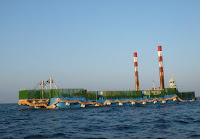 |
| Photo #5 |
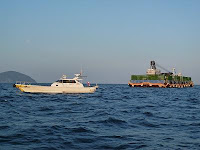 |
| Photo #6 |
The boats from Iwaishima, which stood by cautiously until then, protested violently and some of the Chuden ships left, but the workers who remained began pouring gravel into the sea to lay grounds for building the nuclear power plant. “Don’t pollute our source of livelihood with dirty gravel!” Mr. Shimizu, a town councilor of Kaminoseki pleaded along with others from the island. Not only the islanders’ ships were blocked by coast guards’ rubber boats, they were pushed and shoved away. (photo #7)
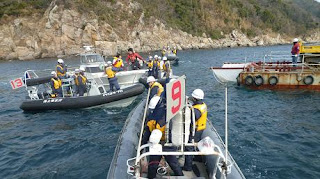 |
| Photo #7 |
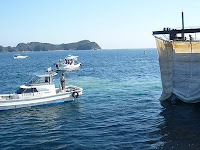 |
| Photo #8 |
The duty of Japan Coast Guard is to guard and protect ships and people on the sea from danger, but it seemed to me that their main concern this day was to protect the safety of Chuden ships as the working ships continued to throw-in gravel into the sea.
(photo #8)
 |
| Photo #9 |
(photo #9)
The gravels were thrown into the sea inside the area supposedly lined with the anti-pollution coverings, but not only did they fail to reach the bottom of the sea, they were full of holes. Fortunately the load capacity of gravel that can be carried by these working ships was limited, and the total amount of gravel thrown into the sea was considerably less for the number of ships that were there.
At the main construction site, ships from Iwaishima lined up to block off the entrance to Tanoura Bay, forbidding single working ship to enter. The effort of Chuden trying to draw an oil fence inside the bay by entering with a small boat was blocked by protesters on kayaks, rafts, and surfboards. That day, on the Tanoura Beach, over 100 people gathered for a violent protest against the blockade. A 69-year-old woman, among other islanders, was injured and carried off to a hospital that day. (photo #10)
 |
| Photo #10 |
After that, the working ships stationed in the sea began to leave for the reason of approaching ill weather, Chuden and coast guard ships also left. Tension was then focused on the protest at the beach, but eventually the battle subsided although the tension related to the plans of building the nuclear power plant will continue.
On March 15, Chuden complied with the request of Yamaguchi Prefectural Governor and Kaminoseki-cho Mayor and announced it will temporarily stop the groundwork of the nuclear power plant construction site, however, they continued the blasting operation on the pretext of “investigation.” The reality was that they were filling the valleys with gravels and dirt made by the blast and developing the site for the plant.
According to Chuden’s publicity department, the “temporary break” of groundwork construction referred to the “development of the site,” and therefore, they insisted they are not telling a lie. On March 22, people objecting the Kaminoseki power plant made an appeal to Chuden Headquarter and Yamaguchi prefectural government and demanded all constructions, including blasting, to stop. The response to this appeal was that the blasting was necessary for investigating the safeness of the nuclear power plant in accordance with the regulations set by the national government; and therefore, “We will continue,” commented Chuden, and “Whether to stop the blasting or not is the decision of the national government and the company undertaking the project,” was the response from the prefectural government.
As to make things worse, Mr. Yamashita, President of Chuden, announced at the press conference held by on March 28 that they will “carry on the project as planned,” which further induced the anxiety of people fearing the effect of earthquakes on the nuclear power plant. The following day, people of Iwaishima and Kayak Group protested at Tanoura. In the unified local election in April, Kaminoseki nuclear power plant project was the main issue of focus by the candidates of surrounding local governments, and a newcomer, Hideto Kunihiro, born and raised in Iwaishima, independently ran for the office of prefectural councilor from Hikari City, 30 kilometers away from the designated plant site. He came very close to two incumbent candidates and lost by mere 197 votes. His catch phrase was, “We are the ones who will create the future – let’s unite in saying no nuclear power plants in the future.” Those who supported Mr. Kunihiro in this election have since then continued to demonstrate against building nuclear power plant by demanding “life without nuclear power.”
カテゴリー:Other
 慰安婦
慰安婦 貧困・福祉
貧困・福祉 DV・性暴力・ハラスメント
DV・性暴力・ハラスメント 非婚・結婚・離婚
非婚・結婚・離婚 セクシュアリティ
セクシュアリティ くらし・生活
くらし・生活 身体・健康
身体・健康 リプロ・ヘルス
リプロ・ヘルス 脱原発
脱原発 女性政策
女性政策 憲法・平和
憲法・平和 高齢社会
高齢社会 子育て・教育
子育て・教育 性表現
性表現 LGBT
LGBT 最終講義
最終講義 博士論文
博士論文 研究助成・公募
研究助成・公募 アート情報
アート情報 女性運動・グループ
女性運動・グループ フェミニストカウンセリング
フェミニストカウンセリング 弁護士
弁護士 女性センター
女性センター セレクトニュース
セレクトニュース マスコミが騒がないニュース
マスコミが騒がないニュース 女の本屋
女の本屋 ブックトーク
ブックトーク シネマラウンジ
シネマラウンジ ミニコミ図書館
ミニコミ図書館 エッセイ
エッセイ WAN基金
WAN基金 お助け情報
お助け情報 WANマーケット
WANマーケット 女と政治をつなぐ
女と政治をつなぐ Worldwide WAN
Worldwide WAN わいわいWAN
わいわいWAN 女性学講座
女性学講座 上野研究室
上野研究室 原発ゼロの道
原発ゼロの道 動画
動画


![[広告]広告募集中](https://wan.or.jp/assets/front/img/side_ads-call.png)











